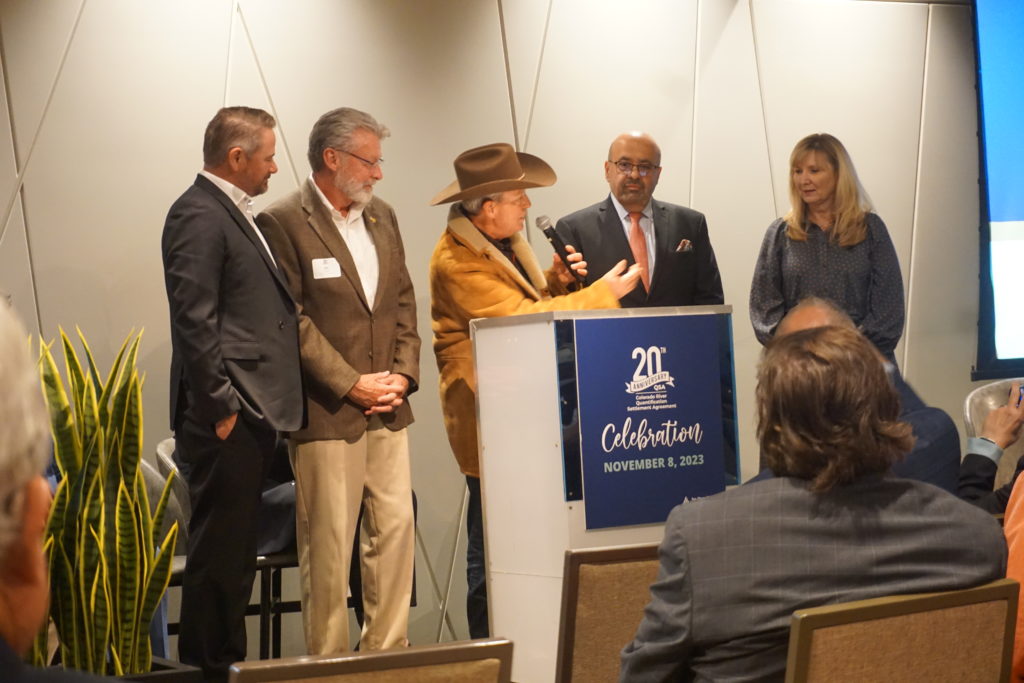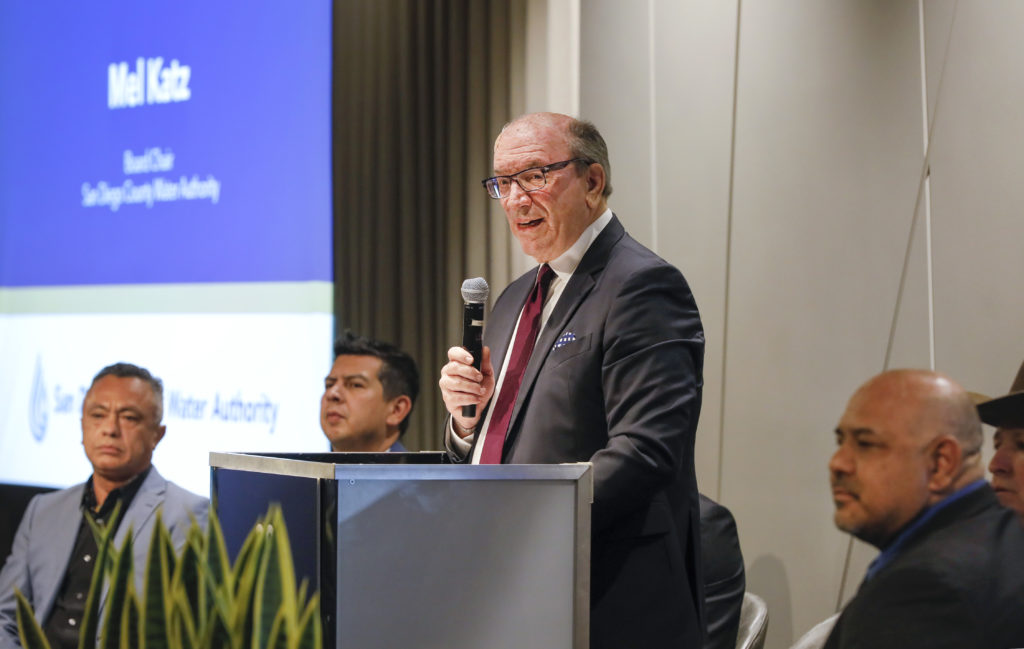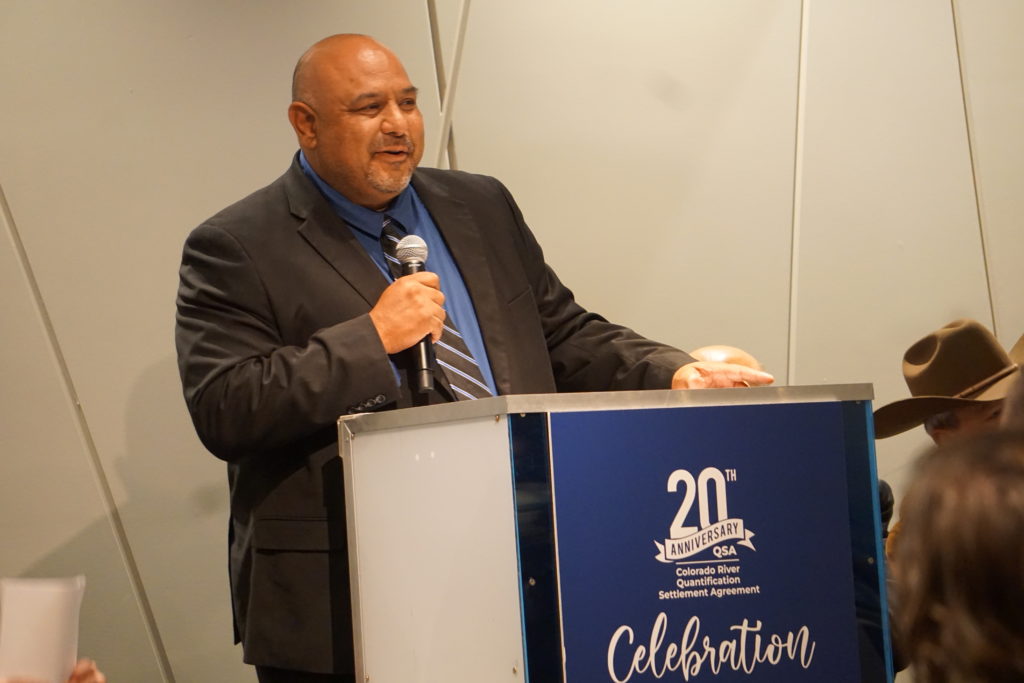
On Wednesday, Nov. 8., representatives from throughout the San Diego region and Southern California gathered in San Diego to commemorate the 20th anniversary of the 2003 Quantification Settlement Agreement (QSA), an historic set of agreements that has enabled California to live within its Colorado River apportionment and helped manage the river for all users. Water leaders talked of how the QSA was not only a model of how to implement voluntary conservation in a mutually beneficial way, but also recognized the strong relationships, trust, and sense of collaboration the QSA established among Southern California’s water agencies. They also highlighted how the QSA continues to meet its goals to provide reliable supplies within California while protecting agriculture and addressing the environment. Looking toward the challenges ahead on the river, they noted the QSA must be a part of critical water discussions moving forward as agencies seek collaborative solutions to ensure the river can continue to serve all who depend on it.
Here are some of the comments made by speakers.

San Diego County Water Authority (Water Authority) Board Chair Mel Katz, who led the event, spoke of the positive change in water management ushered in by the QSA. “What brings us together tonight is the Quantification Settlement Agreement of 2003 – a set of more than two dozen agreements that represent the dawn of a new era in water management in San Diego County and the Southwest – an era of water efficiency and supply reliability despite climate extremes,” he said. Katz also spoke of the importance of the relationships fostered among the QSA partners, and he recognized the efforts of the Imperial Irrigation District (IID) and Imperial Valley farmers for the conservation they have implemented. That conservation is funded by the Water Authority as well as other QSA partnering agencies.
Water Authority General Manager Dan Denham talked of the partnership between the Water Authority, the Imperial Irrigation District (IID), the Metropolitan Water District of Southern California (MWD) and the Coachella Valley Water District. He said the agencies are continuing to work together to ensure there is flexibility in how the river is managed and to ensure the needs of each agency and those they serve are met. “We are getting to a place where we can be creative and do things differently,” he said, adding that the way the agencies are working together “is an example for everyone else in the Southwest and for the Basin to follow.”
Assemblyman David Alvarez, who represents the San Diego region, told those gathered it was important to celebrate what was accomplished through the QSA. “The significance to me of the QSA is the listening that occurred,” he said, noting that the QSA brought agencies together to listen to each other as partners to create a set of mutually beneficial agreements. He credited all the partnering agencies for achieving that goal.
MWD Director Miguel Luna, chair of the Legal and Claims Committee for the MWD Board, emphasized that going forward to address water challenges will take dialogue and building trust. He said those points were key to the success of the QSA. “It took hard work, it took compromise, it took building trust. That success now is a model for what we need to do across the state.”
MWD General Manager Adel Hagekhalil called the QSA a great success. “We all came together. It was tough, but it was important,” he said, adding that “the QSA was a great lesson for all of us,” in that it taught agencies how to work together. Going forward, he said, agencies again must work together in ways that “create water resilience without leaving anyone behind.” He emphasized the importance of protecting agriculture while also serving the needs of urban communities.

IID Board President Alex Cardenas talked about the importance of relationships created by the QSA. He said the QSA began as a transactional relationship between IID and the Water Authority but has grown into a more of a family relationship. He recognized that the Water Authority, as a partner to IID, has shown support for farming and for the Imperial Valley’s communities. He further highlighted the conservation effort undertaken by IID and Valley farmers, noting that over the last 20 years, they have conserved 7.5 million acre-feet. He added that under the QSA, this conservation has moved forward while still enabling agriculture to succeed, pointing out that Valley’s agricultural economy has grown from $1.8 billion in 2003 to $2.6 billion today, according to the latest crop reports. “We are doing something right,” he said. Another point Cardenas made was that the Salton Sea must continue to be addressed and while positive steps have been taken, efforts at the sea must continue.
California Natural Resources Agency Secretary Wade Crowfoot spoke to those gathered via a pre-recorded video. He talked of the QSA as a necessary “game changer” that remains as important today as it was 20 years ago. He also credited the vision of all those involved in the QSA for their innovative efforts to make the QSA work. “Leaders from San Diego, Imperial Valley, state and federal agencies quickly came together to reduce the use of the Colorado River water in California through, at its time, and remains that way today, the largest water transfer from an agricultural region to an urban region in American history,” Crowfoot said. He further credited the QSA partners for stepping up with innovation and resources to make the QSA possible. Looking ahead, Crowfoot talked about how that same innovation needs to continue to build drought resilience amidst climate change.
U.S. Senator Alex Padilla, who represents both San Diego and Imperial County, also joined the event through a pre-recorded video. He shared how through the QSA California water users came together to accomplish a goal no other state had ever done. “We agreed to a voluntary transfer of water that permanently reduced overuse of the Colorado River,” he said. “With creative, collaborative solutions, we prioritized our communities’ long-term water supply while keeping our agricultural regions productive and protecting the environment around us.” He credited the leadership of all the QSA partners for their efforts to sustain the QSA.
Colorado River Board of California Vice Chair Jim Madaffer, also a director on the San Diego County Water Authority Board, talked of how the QSA provides a model for how to be flexible in managing the river in a way that upholds the Law of the River. He made the point, “The QSA must be incorporated into discussions regarding the post-2026 guidelines,” and added, “also, the Salton Sea must be part of those discussions.” He stated the lesson that has come from the QSA “is that we are so much better when working together than separately.”
